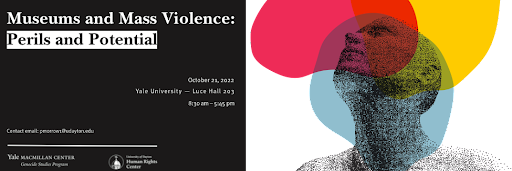Let's Talk Human Rights

Museums Making Efforts to Address Difficult Histories
By Paul Morrow
The past year has seen significant upheavals in the museum world. Fine Arts museums in Europe and North America have struggled to respond to calls to repatriate objects looted or otherwise misappropriated during colonial conflicts. US Civil Rights museums have faced criticism for failing to fully reckon with contemporary racial injustices. Add to this the lingering impacts of COVID-era museum closures and the acute threat to Ukrainian cultural sites posed by Russia’s invasion and the perils of doing museum work in 2022 are evident.
In response to these upheavals, I recently organized a symposium on the theme “Museums and Mass Violence: Perils and Potential” with our partner, Leora Kahn from PROOF: Media for Social Justice. Conceived as a follow-up to museum sessions at the 2021 Social Practice of Human Rights conference, this event was co-sponsored by the HRC and Yale University’s Genocide Studies Program to bring together academics, museum curators, and memorial designers for two days of productive conversation in New Haven. It spotlighted the global nature of the issues, featuring professionals active in Australia, South Africa, Laos, Argentina, and the UK, as well as the US and Canada.
Sociologist Amy Sodaro and Anthropologist Erica Lehrer opened the event with a powerful conversation about the perils and potential of exhibiting mass violence in museums. Sodaro, a co-organizer of the symposium, introduced the notion of “difficult knowledge,” defined as knowledge that relates to historical trauma and places significant emotional and intellectual demands on visitors. Lehrer called attention to the fact that what is difficult for one audience at museums is not always difficult for another. Given that most of the world’s museums are rooted in, if not thematically focused on, mass violence, designers and curators must work purposefully to “reconcile those legacies of racism and elitism before attempting to be beacons of repair.”
Four key questions shaped the subsequent conversation about reconciliation and repair. The first question asked what role politics play in directing or disrupting coverage of mass violence in state memorial museums. Speakers with diverse experiences as designers, directors, and scholars of such museums discussed the challenge of addressing the Uyghur genocide in European museums whose collections stem from colonial expeditions; the problem of identifying and honoring Hutu rescuers of Tutsis during the Rwandan genocide; and the politicized battles over memory of the late-20th century “Dirty War” in contemporary Argentina. Attendees asked provocative questions about whether it was necessary to change the culture of museum going, with its focus on simulation and superficial engagement, in order to better convey difficult historical truths, and likewise questioned the ability of museums to address not just individual visitors but larger social structures.
The second question concerned the ways in which digital technologies are transforming museums’ presentation of mass violence. Participants described their experiences testing augmented reality apps at Dachau and encountering photo-portraits from the Cambodian genocide in high-end furniture stores. An additional topic was the increasing potential of using digital technologies to reconstruct long-shuttered museums of mass violence, via their physical and digital traces.
A third line of inquiry explored the perils and potential of displaying America’s history of racial atrocities in museum spaces. The group considered who ought to be the principal audience for exhibitions on lynching and other forms of racial terror, as well as the best method of responding when museums or exhibits devoted to racial repair encounter criticism for providing merely symbolic reparations. Additionally, an expert presentation on the creation of a traveling memorial called “Society’s Cage” explained how designers “took the ugliness of racism and turned it into something beautiful in order to draw people in for uncomfortable conversations about race and human rights.”
The final question for the symposium focused further attention on the design of atrocity exhibits. Contributors discussed the Legacy Archive created during Canada’s National Inquiry into Missing and Murdered Indigenous Women and Girls (NIMMIWG), the decisions about architecture and location modelled by South Africa’s Apartheid Museum, and the design of the HRC’s own Ferguson Voices exhibit, undertaken by the Moral Courage Project.
Coming away from this symposium, participants committed to further investigating the perils and potential of confronting mass violence in museum spaces. In a planned publication, speakers will deepen their reflections on the relationship between museums and large-scale social change, and on the power of museums to stage individual and collective confrontations with difficult histories. Additionally, participants expressed interest in collaborating on emerging professional initiatives, such as working groups on the ethics of digitizing material artifacts and policies related to the accession of “awkward objects” (i.e. objects that are difficult to make sense of or that provoke curatorial misgivings) into museum collections. Continuing to research and share lessons learned about this important topic is a crucial step towards integrating museums more completely into the social practice of human rights.
Paul Morrow is a visiting assistant professor of philosophy at the University of Dayton, cross-appointed in the University’s Human Rights Center. He has published essays and articles on Holocaust museums, children’s art in wartime, and human rights advocacy on TikTok.
